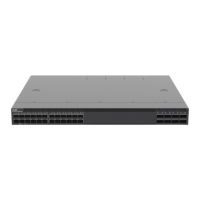Hardware Installation and Reference Guide Appendix
55
Reversed installation direction of the arrester. Connect the external Ethernet cable to the IN end and connect
the Ethernet port of the switch to the OUT end.
Poor grounding of the arrester. The ground cable of the arrester should be as short as possible to ensure
that it is in good contact with the ground terminal of the switch. Use a multimeter to confirm the contact
condition after the grounding.
Incomplete arrester installation. If there is more than one port connected to the peer device on the switch,
arresters need to be installed on all connection ports for the purpose of lightning protection.
7.4 Cabling Recommendations in Installation
When the switches are installed in a standard 19-inch cabinet, the cables are tied in the binding rack on the
cabinet by the cable management bracket, and top cabling or bottom cabling is adopted according to the actual
situation in the equipment room. All cable connectors should be placed at the bottom of the cabinet in an orderly
manner instead of outside the cabinet easy to touch. Power cables are routed beside the cabinet, and top cabling
or bottom cabling is adopted according to the actual situation in the equipment room, such as the position of the
DC power distribution box, AC socket, or lightning protection box.
Requirement for the Minimum Cable Bend Radius
The bend radius of a power cord, communication cable, and flat cable should be over five times greater than
their respective diameters. The bend radius of these cables that often bend or suffer removal/insertion should
be over seven times greater than their respective diameters.
After cabling is fixed, the bend radius of a common coaxial cable should be over seven times greater than its
diameter. The bend radius of this type of cables that often bend or suffer removal/insertion should be over 10
times greater than its diameter.
The bend radius of a high-speed cable (SFP+ cable, for example) should be over five times greater than its
diameter. The bend radius of this type of cables that often bend or suffer removal/insertion should be over10
times greater than its diameter.
Requirement for the Minimum Fiber Bend Radius
The diameter of a fiber tray to hold fibers should be over 25 times greater than the diameter of the fiber.
When an optical fiber is moved, the bend radius of the fiber should be over 20 times greater than the diameter
of the fiber.
During cabling of an optical fiber, the bend radius of the fiber should be over 10 times greater than the
diameter of the fiber.
Precautions for Bundling up Cables
Before cables are bundled, correctly mark labels and stick the labels to cables wherever appropriate.
Cables should be neatly and properly bundled, and no twisting or bending is allowed, as shown in Figure 7-
6.
Figure 7-6 Bundling up cables (1)

